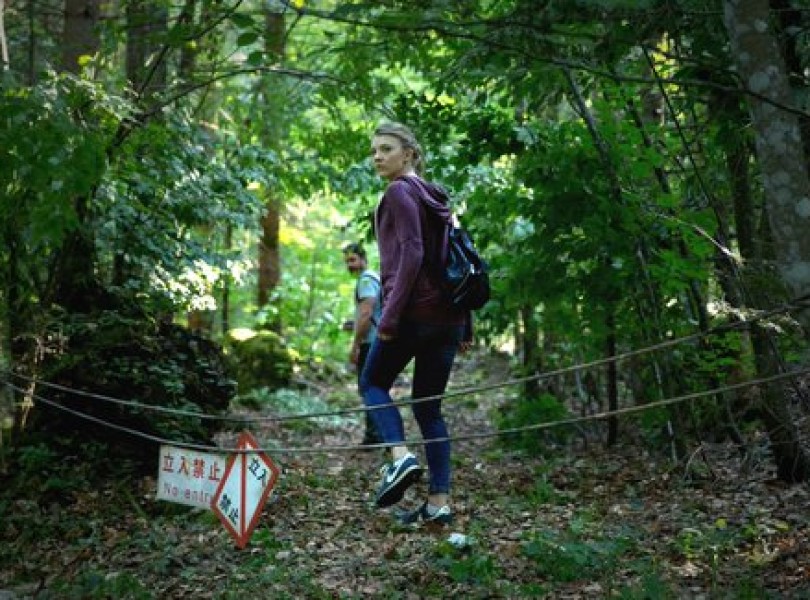The forest is real, ghosts or not.
The Forest, a new supernatural horror movie from first-time director Jason Zada, producer David Goyer and starring Game of Thrones’ Natalie Dormer, follows some familiar paths as other psychological thrillers: a character, in this case Dormer’s Sara, is bottling up significant trauma from herself, and it’s not until a paranormal occurrence takes place that she is forced to face it, for better or worse.
This time around, Sara is pulled out of her pleasant life with her husband Rob (Eoin Macken) in DC when she learns that her twin sister Jess (also played by Dormer) has gone missing in Japan. Authorities have given up hope of finding Jess alive after they learn that she disappeared in Aokigahara Forest, also known as Japan’s suicide forest. Convinced her twin hasn’t taken her own life, Sara flies to Tokyo alone to try to track down her missing sister.
We want to hear it.
A traumatic event in the sisters’ youths left both of the sisters emotionally damaged, though Jess is the only one who shows it. She faces her demons head on, which typically means Sara needs to come to take care of her younger sister, but it’s Sara that is hurting more for not being able to address her issues. When Sara lands in Japan, she is an outsider, and her journey to and into Aokigahara Forest sees her ignoring the warnings that the more spiritually connected Japanese people she encounters repeatedly give her.
Sara can be forgiven for brushing off these words of caution around the popular suicide spot because of her singleminded focus on saving her sister, but The Forest cannot. Suicide is a large and present issue in Japan (an average of 70 people killed themselves a day in 2014), and Aokigahara Forest is one of the most popular suicide spots in the world. But while Sara and the other characters in the movie encounter both successful suicide attempts and people in the forest considering taking their own life, there is no exploration of this as an actual crisis in Japan; it’s a plot device for the sake of a good scare, and that comes across as crass.

The Forest could and should have been more thoughtful about its appropriation of a cultural touchstone as significant as Aokigahara Forest. Instead, it takes the forest’s real history and mythology about the yurei, or spirits of suicides who are trapped in the forest, and adds more supernatural layers to suggest that The Forest as an entity can force people to go mad and trick them into taking their own lives. In the production notes for the film, Goyer admits that the people behind the film “hope The Forest makes people afraid of going into the woods in the same way that Jaws made people afraid to go swim in the ocean.” But this isn’t just any forest, and the movie shouldn’t have treated it as such.
Some of The Forest was filmed in Japan, in Tokyo and at the base of Mount Fuji for some exteriors, but the actual Aokigahara Forest sequences were filmed in Tara National Park in Serbie because filming in Aokigahara is not permitted. Even with a replacement forest, Director of Photography Mattias Troelstrup’s cinematography in The Forest is gorgeous, and turns the foreboding, unwelcoming landscape into its own character in a far more effective way than the repeated use of yurei does.
The Forest does draw out its horror well, building up a sense of tension that pays off with both actual scares and jump gags. It’s hit-or-miss with some of its personal arcs, with its exploration into the way the forest manipulates Sara and Jess’s childhood trauma working well, while its twists with Aiden and resolution with Sara and Jess’s storyline are less comprehensible and more convoluted.
We want to hear it.
Fortunately casting Dormer as the movie’s leads was a great choice, as she slips into both roles seamlessly and adds many layers to Sara’s descent into madness. Similarly well cast is Taylor Kinney as Aiden, a journalist who Sara meets at Aokigahara Forest and who ends up potentially being as big a threat as he is help. (And I’m not just saying this to be coy, because the movie — perhaps unintentionally — leaves his ultimate motivations very unclear.)
Together they ground the movie as it slips through some original plot territory but ultimately concludes with a predictable plot twist. Though The Forest teeters on the brink of making the audience question reality from horror for much of its runtime, it ends with a shot that leaves you wishing there had been a bit more subtlety.
There are some good scares in The Forest and the film does work as a psychological horror story, but its lack of representation of the real-world horrors of Aokigahara Forest dilutes the effectiveness the movie is going for. Dormer and Kinney deliver solid performances and The Forest is visually stunning to look at. Ultimately the film’s exploration into madness and the supernatural comes off feeling familiar, even if those subjects haven’t been shown in exactly this way before.



